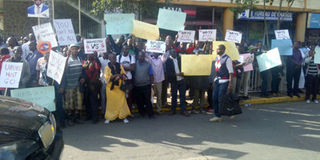Where case could stand or fall and a plea to protect the poor

Nasa supporters display placards outside the Supreme Court building on August 18, 2017. Nasa has filed a petition at the Court concerning the presidential election results. PHOTO | SAM KIPLAGAT | NATION MEDIA GROUP
What you need to know:
- My hope is that this will offer an opportunity for Nasa and the IEBC to present and discuss their evidence transparently.
On Wednesday, Mr Raila Odinga declared — on behalf of the National Super Alliance (Nasa) — that, “with the raid on civil society and determination to silence all voices that could seek legal redress … we have now decided to move to the Supreme Court” to challenge the presidential election results.
Like many, I am concerned about the recent attacks on civil society.
But I am glad that Nasa have decided to take their dispute to court.
TRANSPARENCY
My hope is that this will offer an opportunity for Nasa and the Independent Electoral and Boundaries Commission (IEBC) to present and discuss their evidence in a systematic and transparent manner.
However, to ensure that the results can be checked, it is absolutely essential that all of the form 34As, which record polling station level results, and form 34Bs, which record constituency level tallies, are made available.
At the time of writing, it seemed that almost 6,000 form 34As were yet to be made public. This is a serious problem.
HONESTY
First, Nasa need to be able to check that the forms 34A and 34B used by the IEBC are the same as those given to, or photographed by their party agents.
Second, they need to be able to check that all of the form 34As for a constituency add up to the totals recorded on form 34B, and that these constituency level results then add up to the overall result.
This is important as it is the best way to assess whether or not President Uhuru Kenyatta won by a margin of 1.4 million votes as announced; whether there was some manipulation of the results; or whether, as Nasa claim, Mr Odinga actually won.
FREEDOMS
Another issue raised by Nasa is how “peaceful assembly is guaranteed by the Constitution. So is civil disobedience. So is the right for labour to strike”.
This is true, and it is important that these rights be protected.
However, recent events highlight two other long-standing and deep-rooted problems; namely, a culture of impunity within the security forces, and a situation whereby many poor Kenyans and, particularly poor young men in informal settlements, have been cast as actual or potential criminals.
PROTESTERS
Why do I say this? After the polls closed on August 8, and after the results were announced on August 11, security forces cordoned off certain informal settlements in Nairobi and Kisumu.
According to media and human rights reports, some security officers then proceeded — in the face of limited protest — to use excessive force against a number of protesters and non-protesters alike.
According to the Kenya National Commission on Human Rights, at least 24 people lost their lives in these areas between August 8 and 12 due to the use of live bullets by security officers.
ASSAULT
Additional reports suggest that some residents became victims of sexual abuse, while others were beaten.
These include two 17-year old Form Four students who were reportedly dragged out of a house in Mathare, Nairobi, on Friday evening by police officers and beaten.
One of the two, Silas Lebo, later died from his injuries.
It also includes a six-month old baby who died after reportedly being hit over the head by a police officer’s baton in Nyalenda, Kisumu.
VIOLENCE
To make sense of such brutality one needs to place events in a broader context.
First, a common perception that protest is always, or is usually, violent.
This is important as it feeds an assumption that, if someone was protesting, they were probably being, or were likely to become, violent.
A logic that then helps to justify the use of both reactive and deterrent force.
POLICE
Second, it speaks of a culture of impunity; and, third, of a tendency to criminalise the poor.
In short, limited protest of extra-judicial killings outside of the electoral cycle on the basis that those killed are likely criminals in the absence of hard evidence points to a reality in which poor young men are often cast as real or potential criminals.
It is this combination of factors, which I believe helps to explain how security officers responded to recent events with such brutal force.
VERDICT
These issues of the petition and protest may seem unrelated, but they are not.
Since, whatever the Supreme Court decides — either that Kenyatta won the election, or that a new election be held — there will likely be some who are unhappy with the verdict.
These people should be permitted to engage in peaceful protest; their neighbours should not be punished; and, in the longer run, the question of how sections of society are so quickly cast as actual or potential criminals should be addressed.
Gabrielle Lynch, Professor of Comparative Politics, University of Warwick ([email protected]; @GabrielleLynch6)





